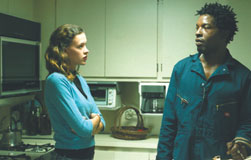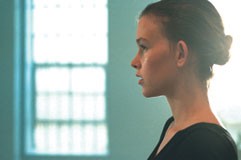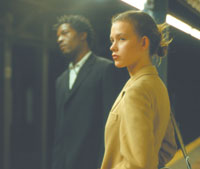TOP OF THE CLASS
Kevin Asher Green would have preferred to shoot his debut feature Homework on 35mm, with long-take, deep-focus static shots in the style of his hero Tsai Ming-liang. But with only $10,000 to work with, he was forced to shoot on digital. The stylistic gamble paid off, as the film ended up winning the Grand Jury Prize at Slamdance 2004. Scott Macaulay reports.
 |  |
|
Kevin Asher Green's Homework, starring Isaach De Bankolé and Paz de la Huerta. The film won the Grand Jury Prize at the 2004 Slamdance Film Festival. | |
I hate video with a passion,” says writer-director Kevin Asher Green of the medium that spawned his first feature, Homework, a minimalist tale of a teenage ballet dancer and her obsessive relationship with a handsome black plumber. “My favorite filmmakers — [Abbas] Kiarostami, Hou Hsiao-hsien and Wong Kar-wai — shoot these lush 35mm films with beautiful wide shots, so it was hard for me at first to work in video. But if you think about the medium’s strengths and weaknesses, you can make it work.”
Shooting his film on a Sony PD-150 PAL Mini DV camera with a tiny $10,000 budget, Green did indeed “make it work” — the film won the Grand Prize at this year’s Slamdance Film Festival and earned raves for its carefully crafted digital aesthetic.
One of the film’s most impressive achievements is its success at creating a hypnotic cinematic experience based not on giant plot turns or overly dramatic performances but on subtle changes in tone and rhythm. That Green was able to achieve this with Mini DV, a format more often used by no-budget filmmakers to capture a deliberately rough-hewn reality, is all the more impressive. But it couldn’t have been any other way. With a screenplay influenced by the terse, sometimes elliptical films of Hou, Benoît Jacquot and particularly Tsai Ming-liang, Green needed to seduce his viewers with controlled visual compositions and an assured editing style to draw them into a story that, if poorly executed, would seem ephemeral or esoteric.
|
The finished screenplay, written to utilize a few key locations Green knew he’d get for not much money, beats Lost in Translation’s 70 pages in the brevity department. “It was 57 pages,” says Green, “mostly with description but not very much dialogue.” Realizing that the screenplay by itself couldn’t convey his vision, Green also shot a series of digital photographs that captured the precise visual aesthetic he was going for. He cropped the images to 1.85 and printed them in a book he’d use to explain the film. Still, despite Stark’s support, Green imagined that the film “would be shot by me and a few friends on weekends.”
“But then,” Green continues, “I met Anthony Katagas and Callum Greene at Keep Your Head Productions. They came on board as producers, and that’s when everything really took off. They helped me get my other two actors [Paz de la Huerta and Evan Neumann] and my d.p. And then my tiny baby project became a two-week shoot with really great people.” The crew for those 12 shooting days consisted of d.p. Richard Rutkowski, a costume designer and wardrobe supervisor, a script supervisor, a production designer, a sound man, a lighting assistant and a camera operator. Later, Michael Taylor, a top New York script supervisor who had worked with Ang Lee, Marc Forster and Terry Zwigoff and studied editing at New York’s Edit Center, came on board to cut the film.
Rutkowski had worked in digital several times before as co-d.p. with Tom Richmond on Ethan Hawke’s InDigEnt production Chelsea Walls and as d.p. on Neil Burger’s Interview with an Assassin, which earned him an Independent Spirit Award nomination. For Green it was important that he had a d.p. who was already skilled in the digitally shot image. “Sometimes these guys who come from film and try to do video don’t make the step very smoothly,” Green says. “Video is not film, and you can never shoot it like film. It’s got to be lit in its own special way, and it has to be reworked in its own special way.”
“I think what was most important in the visual success of Homework was the collaboration between Kevin and myself that was able to occur during prep,” Rutkowski says. “Kevin had a fairly clear idea of the look he was after, and when a director is able to talk in terms of color, framing, and image texture right away, the capabilities of the d.p. become magnified.”
“Because I love beautiful movies,” adds Green, “I wanted to make sure that we didn’t have any of the problems inherent with shooting video, like overly harsh colors. You know, in In Praise of Love Godard actually changed the backgrounds and clothing patterns on people to make [video] look even worse, to play up the hideousness of it. I was obsessed that we [not have that look], so we shot and lit the film to take most of the color out and create a monochromatic look.”
 |
| Homework. |
Rutkowski says that he and the director spent a considerable amount of time in preproduction defining the color palette they’d be using. “I played around a lot with the color balance of the cameras by using the white balance feature,” he says. “We’d go to a location we knew we’d be shooting at, set up a simple lighting scheme with a stand-in, and would shoot with different exposures and different color looks. Then we’d look at the tape and discuss the result.”
Rutkowski shot with a Tiffen Pro-Mist filter — “a filter that desensitizes a little bit of the harshness of video,” says Green — on top of the lens the whole shoot. With regards to lighting, the d.p. comments, “Video responds much better to softer light sources, so I went with Kino Flos a lot, in both color temperatures, for both day and night interiors. Sometimes these would have diffusion material like Lee 250 or 251 clipped to the outside and then be either bounced off walls or brought in through a final layer of thin diffusion like 252 or Hampshire Frost. My biggest instrument, and a very versatile one, was the 200 watt HMI Joker kit. I also own a set of Lowell D lights which are 1000 watts open face and have a lot of punch for their small size. All of these instruments plugged into the wall, but we had to keep things spread around the locations to avoid tripping circuit breakers. I also had a few 650 watt and 300 watt fresnels, but again, I rarely point these straight at the subject or get into traditional three-point lighting because on video it pretty quickly starts to look like a nightly news setup.” In addition to the diffusion, Rutkowski added smoke or mist to most of the interior locations, “to add a nice gloss element to the image without making it too soft when viewed in large projection.”
|
Some d.p.’s discuss the process of shooting DV as simply a precursor to color-correcting the film in post and transferring to film. Rutkowski, however, says he regularly uses lens diffusion, mist and other techniques to build as much of a digitally shot film’s final aesthetic in camera during shooting as possible. When shooting Homework, he says, “there was a concern with getting images that could blow up to film successfully, but I would argue that accurate exposure that gives you the ability to transfer to film without undue artifact or video noise is something you should be aiming for anyway. And even when a project needs a bit of the rough-and-ready video look, like for example Interview with the Assassin did, I still try to light and expose for the impression of that look and not just set the camera on automatic and go.”
Another remarkable note about Homework is that the copy that’s being shown on the festival circuit is an output from Final Cut Pro rendered in QuickTme 3, and all color correction was done in the Final Cut system. “A lot of [the color correction] came out well,” says Rutkowski, but “generally I am a proponent of going into a high-end video suite — a Da Vinci or such — to do final corrections before outputting to film. First of all, the accuracy and clarity of the monitor [in those suites] is really important — no computer screen or small prosumer monitor can match that. Also the level of finesse [available] within each hue and the [range] of subtle adjustments to contrast and gamma are greatly expanded. When it comes to a particularly dark or troubled scene, some shots are just beyond the capabilities of Final Cut’s internal correction. Also I like to add the occasional subtle softening at the corners of the image [to simulate film optics], and the render times — not to mention the computer memory required — for these effects is just too much [for the Final Cut system] when compared to the relative ease and real-time viewing of a real post suite.”
Like a lot of American indies who sport world cinema influences, Green thought that he’d find the most support for his film in Europe, but Homework’s biggest raves have been at Slamdance and, more recently, SXSW. “I was under the impression that I would make a different kind of American film and have the Europeans embrace it,” he says with a laugh, “but I’m seeing the opposite effect. The Americans are embracing it, and Europe doesn’t seem to care as much!”
While he screens Homework for distributors, Green is working on several projects that straddle a variety of budgets. There’s his “CinemaScope kind of Sergio Leone story in New York City with an ethnic cast” and then his story “about a supermarket and the consumer nature of America, which will be a mixture of video and film.” But he’s also looking for other writers’ screenplays to direct. “I’m a little scared of making $300,000 features for the rest of my life, although I’d probably love to. If I won the lottery, I’d probably want to do things bigger, but I do love the intimacy of a small crew.”
Go to Sidebar: Doing the Math on Homework
VOD CALENDAR


 See the VOD Calendar →
See the VOD Calendar →


